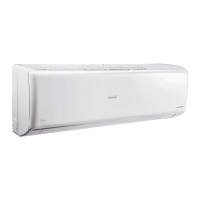
Do you have a question about the Toyotomi HTN/HTG20-09R32 and is the answer not in the manual?
| Cooling Capacity | 2.0 kW |
|---|---|
| Heating Capacity | 2.5 kW |
| Power Supply | 220-240V, 50Hz |
| Refrigerant | R32 |
| Noise Level (Outdoor) | 50 dB(A) |
| Noise Level (Indoor) | 38 dB(A) |
Guidelines for safe operation, cleaning, and user maintenance of the air conditioner.
Electrical safety regulations, circuit breakers, grounding, and wiring requirements for installation.
Specifies the operating temperature limits for cooling and heating modes.
Identification and labeling of the components of the indoor unit.
Detailed explanation of each button on the remote control and their functions.
Instructions for safely replacing the batteries in the remote control unit.
Method for cleaning the exterior surface of the indoor unit.
Step-by-step guide for removing, cleaning, and reinstalling the air filter.
Pre-season checks for the air conditioner unit to ensure proper functioning.
Post-season checks and maintenance recommendations for the air conditioner.
Information regarding recycling and disposal of the air conditioner unit.
Troubleshooting common issues and providing solutions for the air conditioner.
List of error codes displayed by the unit and their corresponding troubleshooting steps.
General requirements to avoid malfunction and ensure proper unit placement.
Guidelines for selecting an appropriate location for the indoor air conditioner unit.
Guidelines for selecting an appropriate location for the outdoor air conditioner unit.
Essential safety measures for connecting the air conditioner to the electrical supply.
Specific instructions and importance of proper grounding for electrical safety.
Guidance on selecting the optimal location for the indoor unit installation.
Instructions for securely mounting the indoor unit's frame to the wall.
Procedure for drilling the wall hole for refrigerant pipes and drain hose.
Details on routing the refrigerant and drain pipes from the indoor unit.
Steps for connecting the refrigerant pipes to the indoor unit correctly.
Procedure for connecting and securing the drain hose for condensate removal.
Instructions for connecting the electrical wiring to the indoor unit.
Guidance on bundling and insulating the refrigerant pipes and wires.
Steps for safely hanging the indoor unit onto the wall-mounting frame.
Mandatory qualifications and certifications for personnel handling refrigerant systems.
Specific installation requirements and restrictions related to flammable refrigerants.
Key points to check regarding the maintenance area and ventilation.
Procedure for cutting or welding refrigerant system pipes during maintenance.
Guidelines for safely filling the system with refrigerant R32.
Safety measures for handling, transporting, and storing the air conditioner.
Instructions for selecting a location and fixing the support base for the outdoor unit.
Procedure for connecting the drain joint for condensate removal from the outdoor unit.
Steps for mounting and bolting the outdoor unit onto its support.
Detailed steps for connecting the refrigerant pipes between indoor and outdoor units.
Instructions for connecting the power and signal control wires to the outdoor unit.
Guidance on routing and securing the refrigerant pipes and drain hose.
Procedure for performing vacuum pumping on the refrigerant lines.
Methods for checking the refrigerant system for leaks after installation.
Checklist of items to verify after installation for proper unit function.
Important notes and client instructions before starting the test operation.
Steps for performing the test operation and checking unit modes.
Procedure for inspecting the quality of the flared pipe ends.
Safety guidelines for operating and maintaining the air conditioner unit.
Specifies the operational temperature limits for cooling and heating.
Diagram identifying the main parts of the indoor unit.
Functions activated by pressing multiple buttons simultaneously.
Instructions on how to replace batteries in the remote control.
Instructions for cleaning the front panel of the indoor unit.
Detailed steps for cleaning the air filters of the unit.
Information on recycling and proper disposal of the air conditioner unit.
Diagnosing and resolving issues when the indoor unit does not respond to remote commands.
Troubleshooting steps when no air is emitted from the indoor unit.
Resolving issues where the air conditioner fails to start or operate.
Explanation and troubleshooting for white mist appearing from the indoor unit.
Resolving problems related to setting or adjusting the desired temperature.
Troubleshooting steps for poor cooling or heating efficiency.
Identifying and resolving causes of odors emanating from the air conditioner.
Addressing unexpected activation or deactivation of the air conditioner.
Explanation for vapor appearing on the outdoor unit during heating mode.
Understanding and troubleshooting noise from refrigerant flow within the unit.
Explanation for cracking sounds due to thermal expansion and contraction.
List of error codes and their meanings for diagnosing unit faults.
General requirements for choosing installation locations to prevent malfunctions.
Guidelines for selecting an appropriate site for the indoor unit.
Guidelines for selecting an appropriate site for the outdoor unit.
Mandatory safety guidelines to follow during the installation process.
Guidance on choosing the best placement for the indoor unit.
Instructions for mounting the wall bracket for the indoor unit.
Procedure for creating the wall opening for pipes and hoses.
Routing refrigerant pipes and drain hose from the indoor unit.
Steps to properly connect the refrigerant pipes to the indoor unit.
Procedure for connecting the drain hose to the unit.
Instructions for connecting the electrical cables to the indoor unit.
Steps for covering and insulating the refrigerant pipes and wires.
Procedure for mounting the indoor unit onto the wall bracket.
Steps to verify the correct operation of the air conditioner after installation.
Mandatory qualifications for personnel performing installation and maintenance.
Key considerations for installing the unit, including room size and leak checks.
Procedure for cutting or welding refrigerant system pipes, including safety steps.
Safety protocols for handling flammable refrigerant during maintenance.
Guidelines for properly filling the system with refrigerant, including leak checks.
Safety measures for handling and storing the appliance.
Instructions for selecting a location and securely installing the base support for the outdoor unit.
Procedure for connecting the drain hose to the outdoor unit.
Steps for mounting and bolting the outdoor unit onto its base.
Detailed instructions for connecting the refrigerant pipes to the outdoor unit.
Wiring instructions for connecting power and communication cables to the outdoor unit.
Guidelines for routing refrigerant pipes and drain hose along the wall.
Methods for performing leakage checks on the refrigerant system.
Checklist of items to verify after installation for proper unit function.
Procedure for checking the unit's operation modes after installation.
Procedure for inspecting the quality of the flared pipe ends.
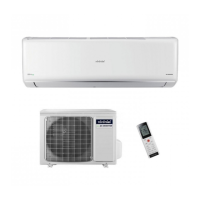
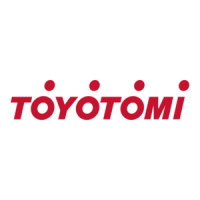
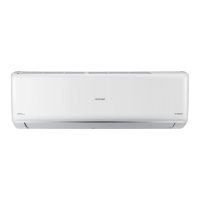

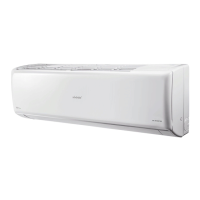
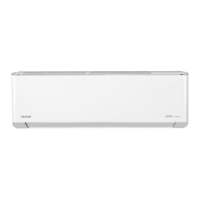
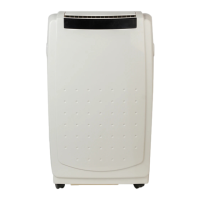

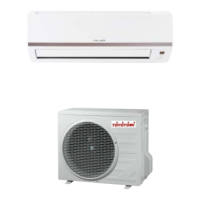
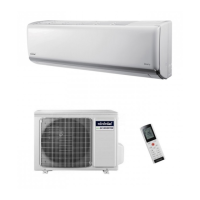

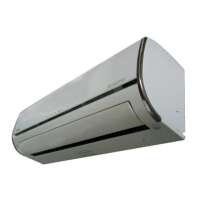
